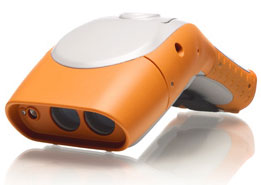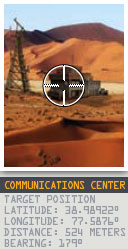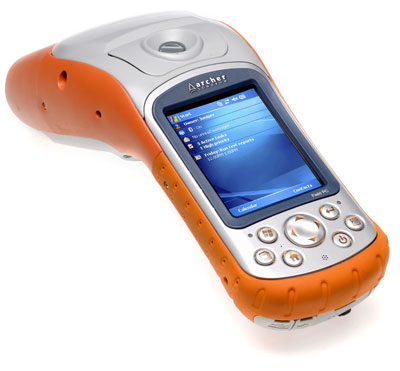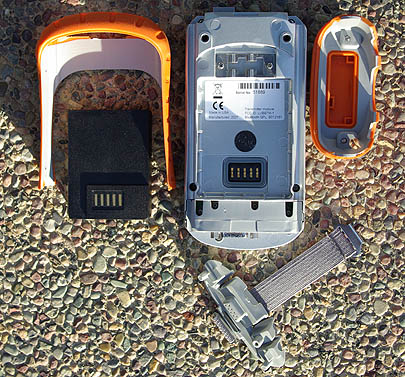|
Juniper Archer Longbow
Combining mobile computer, GPS, camera, compass and laser rangefinder into one handy, rugged remote positioning field tool
(by Conrad H. Blickenstorfer)
Juniper Systems of Logan, Utah, offers the ultra-rugged Archer Field PC for applications in numerous vertical markets from agriculture to forestry to meter reading/data collection to wildlife resources and more. The Archer—which provides full Windows Mobile functionality and excellent connectivity in a virtually indestructable device—is now available in a new version called the Archer Longbow. The Longbow combines the Juniper Archer with Surveylab's patented ikeGPS precision geospatial instrumentation and software.
 The Longbow/IkeGPS version essentially converts the Archer into an all-in-one mobile GIS data capture solution consisting of one of the most rugged handhelds available on the market, a GPS receiver, a 3D compass, a digital camera and a laser rangefinder. The Longbow/IkeGPS version essentially converts the Archer into an all-in-one mobile GIS data capture solution consisting of one of the most rugged handhelds available on the market, a GPS receiver, a 3D compass, a digital camera and a laser rangefinder.
With the Archer already capable of accommodating third-party GPS modules under its optional Universal Cap, where does this new version fit in?  The answer is that the Longbow not only adds DGPS accuracy to the Archer handheld computer, but also the ability to quickly capture position and distance of a target along with a verifyable image. The system enables very rapid GIS data acquisition through Standoff PhotoPositioning where multiple targets up to 3,300 feet distant can all be positioned from a single location. Captured images include geotagged target location information, with crosshairs showing exactly what was captured. The image also shows important ancillary data and information such as coordinates, distance and bearing. This makes the Longbow suitable for situations where targets are difficult to reach or where safety is a concern. Examples are Asset management, research, insurance assessment, disaster relief, environmental work or military engineering. The answer is that the Longbow not only adds DGPS accuracy to the Archer handheld computer, but also the ability to quickly capture position and distance of a target along with a verifyable image. The system enables very rapid GIS data acquisition through Standoff PhotoPositioning where multiple targets up to 3,300 feet distant can all be positioned from a single location. Captured images include geotagged target location information, with crosshairs showing exactly what was captured. The image also shows important ancillary data and information such as coordinates, distance and bearing. This makes the Longbow suitable for situations where targets are difficult to reach or where safety is a concern. Examples are Asset management, research, insurance assessment, disaster relief, environmental work or military engineering.

Here are the basic advantages of the Longbow/IkeGPS over separate components:
- Fully integrated into the design of the Archer host handheld
- Low power consumption to conserve handheld battery power
- Easy to use (just connect and go)
- Only slightly affects overall ruggedness (3.3 foot drop instead of 5-foot drop)
And these are the features of the Longbow version:
- Addition of a Class 1 laser rangefinder with +/-0.5 meter accuracy.
- Addition of an electronic compass with +/- half a degree accuracy within a 0 to 90 degree tilt.
- Addition of a 3.2 or 5.0 megapixel digital camera with up to 30X zoom.
- Addition of GPS with inherent 2-5 meter accuracy and 2 meter accuracy with WAAS and DGPS.
- Software for the above, plus full compatibility with mobile GIS software such as ESRI ArcPad.
The Hemisphere GPS Longbow comes in two parts. There's a special CF adapter that replaces the standard Archer cap, and then there is the completely sealed ikeGPS module itself. The connection between the two is via ultra-reliable spring-loaded pins. The Longbow is available in three versions. The AR-LB100 has a 3-megapixel camera and a maximum laser targeting reach of 100 meters (330 fet), the AR-LB300 has a higher resolution 5-megapixel camera with a 300 meter (1,000 feet) reach, and the top-of-the-line AR-LB1000 also uses the 5-megapixel camera, but extends the reach to a full kilometer (3,300 feet).
Since the Longbow/IkeGPS is based on the Archer Field PC, below is a full review of the underlying Archer computing platform. The pictures to the right are from that review.
The Archer Field PC
The Archer rugged PDA is one tough handheld. Here are the specs that matter:
- If push comes to shove, you can operate the Archer in temperatures as low as -22 degrees Fahrenheit and as high as 130 degrees. Bluetooth only works down to about -4 degrees, but the rest of the Archer works just fine in bone-chilling temperatures. And 130 degrees is about as hot as it gets in places where humans can work and survive.
- As far as the ever-popular drop testing goes, the Archer survives multiple drops from five feet onto concrete. And not just in nice lab conditions. It'll survive those drops throughout its operating temperature range.
- For ingress protection, the Archer rates a stellar IP67. The first number stands for protection against solids. 6 is as high as it gets, and it means the unit is totally protected against the finest dust. The second number is for the degree of protection from liquids. That scale goes from 0 (no protection) to 8 (totally immune to water, even indefinite immersion). A 7 means the device is protected against the effects of immersion into water, up to a certain extent. For the Archer, that means it can survive half an hour or so under a meter, 3.3 feet, of water.
- A special version of the Archer has been certified as "non-incendive" for use in Class I Div 2 areas as well. That doesn't make it intrinsically safe but means it won't arc or spark and doesn't have hot surfaces, all of which can make a device a hazard in certain applications.
- The Archer has also been tested according to the MIL-STD-810F procedures regarding water, humidity, sand and dust, vibration, altitude, shock, high temperature, low temperature, temperature shock and so on. Juniper Systems can supply details.
Protection through intelligent engineering
How did Juniper Systems achieve such stellar ruggedness specs? By adding a whole lot more clever engineering than meets the eye. Don't let the friendly "high visibility" orange pumpkin exterior of the Archer fool you (the orange version is for maximum visibility; a gray one is available also). It's just very well integrated padding and protection. Remove the plastic/rubber elastomer overmold by simply undoing a grand total of six screws and you find underneath an entirely more serious looking piece of equipment.
Below are the pieces of the base Archer Field PC laid out: You can see the orange elastomer parts that provide protection, the backside of the magnesium core, the battery that seals tightly against the contacts, and the rubber plug/handstrap assembly.


Above you can see the bare core of the Archer rugged PDA. It's a rock-solid, brilliantly engineered magnesium case that seems milled from a solid block of metal. How does the Archer manage a IP67 rating when it has all those ports and expansion slots? From what we can tell, by separating things into different compartments. The vulnerable interior with all the electronics is housed inside the magnesium case. The ports at the bottom of the device are mounted in a plastic block screwed onto the magnesium housing. The ports are protected, but not totally sealed, by thick rubber plugs. Even underwater, while a bit of water may get into the connectors, it won't get inside the case because the interface between the connector block and the magnesium housing is sealed.
The situation is different on top of the unit where the two expansion slots are. There are electronics in there and they need to stay dry. Sealing is provided by the elastomer top cap. An o-ring approach (o-ring in principle; Juniper is actually using sealing plates) is used to keep water out, so make sure the top cap is securely screwed down after you've taken it off to insert a card. And make sure nothing is clinging to the sealing surface as that would allow water to penetrate.
The battery compartment is not sealed, so how is water kept from reaching the contacts? Once again, Juniper's engineers used the o-ring approach. The contacts have a rubber seal around them that presses against a flat surface on the battery, keeping water out.
Another smart aspect of this approach is that should the outer padding get cut or ripped, it can be replaced easily and inexpensively. The same goes for the rubber flap with the four individual protective plugs.
Technology
The Archer is powered by the 520MHxz version of the Marvell PXA270 processor. There is 128MB of RAM and 512MB of Flash. The transflective display measures 3.5 inches diagonally and uses the ubiquitous 240 x 320 pixel resolution. The display is just bright enough and is outdoor-viewable, though there is more glare than we like. On the software side, Juniper now uses Windows Mobile 6.1. Compared to the earlier Windows Mobile 5.0 used in older Archers, this provides a variety of improvements, including enhanced security and control, support of the Microsoft Office 2007 file formats in the mobile apps, multiple network connections, new tools and control panels, and a variety of other improvements. Windows Mobile remains a stable, time-tested operating platform with numerous software development tools and a large library of applications.
The Archer has both a Compact Flash Type I/II card slot as well as a SDIO slot. Both are user-accessible after undoing two Philips head screws and removing the top elastomer cap. If you use the Archer with the Hemisphere GPS, the CF Card slot is used by the GPS.
On the interface side, there is a standard 9-pin RS232 port, and two USB ports. One of them is a USB host, using a Mini-A jack, to control other devices. The other is a USB client, using a Mini-B jack, for synchronization with desktop or notebook PCs. The power jack is located next to the USB client. All ports have individual protective rubber plugs.
The Archer can be ordered with integrated Bluetooth Class II. Wireless communication (WiFi or wireless cellular modems) is via SD or CF cards, so if you need WiFi in a Hemisphere GPS-equipped Archer, you need a WiFi SDIO card.
Controls and navigation
The Archer rugged PDA has a sealed resistive touch screen, a 4-way navigation disc, and six hardware buttons. The hardware button, three each on either side of the navigation disc, are backlit and labeled, but they can be reassigned. As is, the buttons bring up the Windows Start menu, the Applications Manager, the Today screen and context menus. There is also an enter button, and a slightly recessed one that turns the device on and off. The touch screen can be operated either with the supplied 4.6-inch long stylus that stows away into a garage on the upper left side of the computer, or with any other stylus or even finger. There are no additional hardware controls.
Size and Ergonomics
Being an ultra-rugged device, the Archer Field PC is larger and heavier than a consumer-grade Pocket PC. The bare Archer unit is 3.5 inches wide, 6.5 inches tall, and about 1.7 inches thick. The computer weighs just over a pound, light enough to carry for hours. The Hemisphere GPS adds about four inches and half a pound.
Except for users with very small hands, ergonomics are excellent. The Archer fits perfectly into a hand and the elastomer protective cladding provides a good grip. An elastic handstrap mounted on the back of the device provides extra security against dropping.
The hardware controls require a firm push and provide tactile feedback. Their backlight is adjustable.
The protective rubber plugs at the bottom can be a bit obstreperous. They need to be guided and require a firm push to be seated firmly into place.
Bottom Line
The Juniper Systems Archer Field PC is a very intelligent design that combines a rock-solid magnesium core with easily-replaceable exterior elastomer protection, making for both superior durability and above-average connectivity and onboard expansion. The device is ergonomically designed, too, and its strong battery easily lasts a full shift or even two. Electronics and software are tried and field-proven, as is the transmissive 240 x 320 pixel display.
The ikeGPS module, designed specifically to seamlessly integrate with the Archer, adds remote laser positioning, DGPS, electronic compass, camera and geotagging for GIS applications that require remote data acquisition.
Overall, the Archer Field PC is a superbly designed, ultra-rugged handheld computer. It's tough enough to handle virtually any abuse, yet small enough to be carried anywhere. This and its powerful battery make the Archer a convincing choice for any number of demanding field applications.
|






